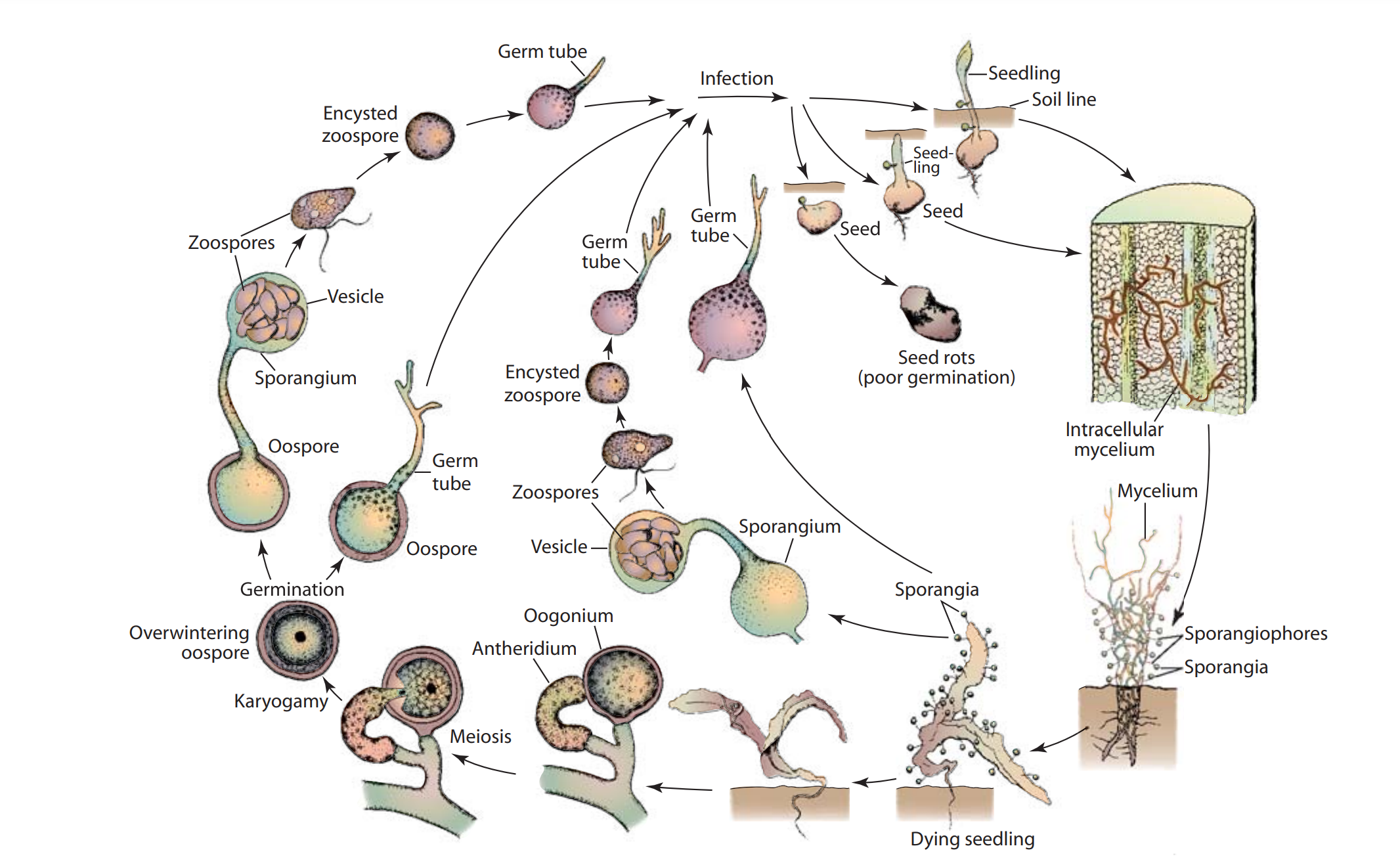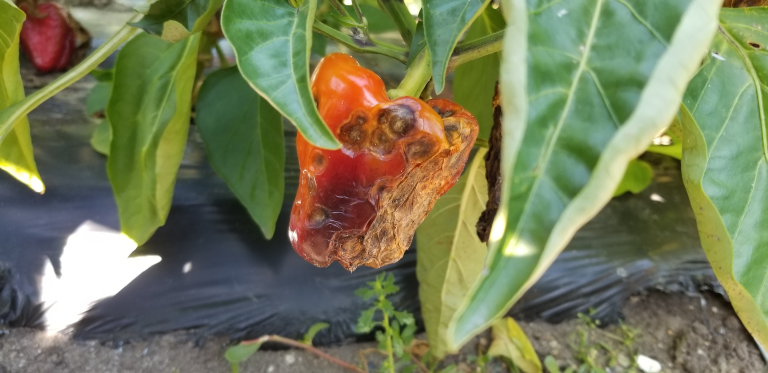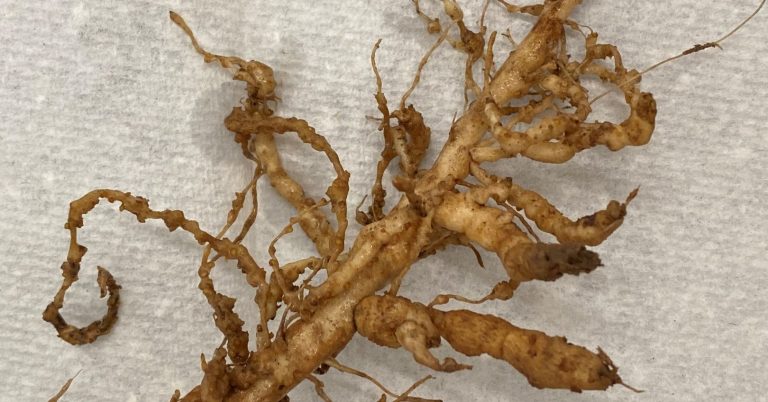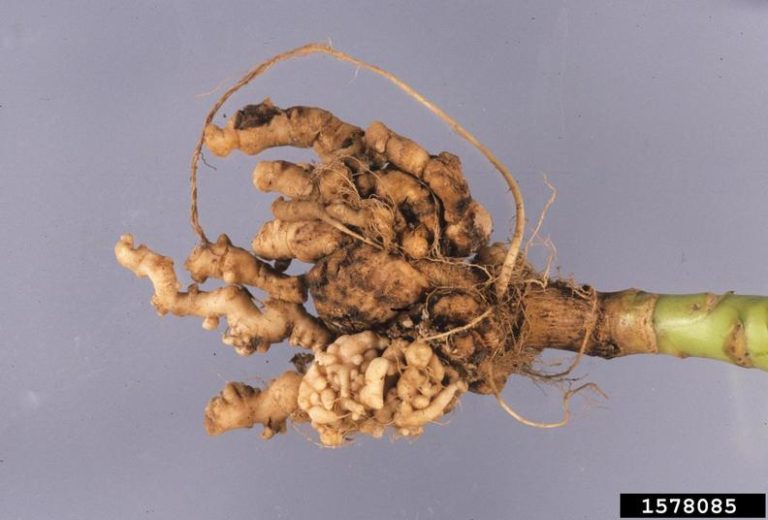Introduction
Damping-off of vegetables is a significant seedling disease that affects a wide range of crops in their early stages. It is caused by various soil-borne fungal pathogens that attack seeds or young seedlings, leading to poor germination, seedling collapse, and reduced plant vigor. This disease can be devastating in vegetable nurseries and fields, where conditions are conducive for rapid fungal growth. The primary fungal culprits behind damping-off include species from genera like Pythium, Rhizoctonia, Phytophthora, Fusarium, and Sclerotinia.
In Nepal, where vegetable farming plays a vital role in rural livelihoods, damping-off of vegetables is a common challenge. Understanding the biology and disease cycle of these pathogens, the conditions that favor their spread, and the appropriate management practices is essential for minimizing crop losses.
This blog post will explore the damping-off of vegetables, focusing on the different fungal pathogens that cause this disease, comparing their symptoms, favorable conditions, disease cycles, and effective management strategies in the context of Nepal.
Comparative Overview of Damping-Off of Vegetable Pathogens
Damping-off of vegetables is caused by various fungal pathogens, each with its unique biology and impact on vegetables. The major pathogens responsible for damping-off are as follows:
| Fungal Pathogen | Common Host Vegetables | Key Pathogenic Features | Disease Development Pattern |
|---|---|---|---|
| Pythium spp. | Tomatoes, cucumbers, lettuce | A water mold that thrives in moist soils; produces oospores for survival. Attacks seeds and young seedlings. | Affects both pre- and post-emergence stages. Seedlings appear water-soaked before wilting. |
| Rhizoctonia solani | Beans, cabbage, radish | Produces both microconidia and macroconidia. It can infect seeds and roots, leading to wilting and root rot. | Primarily post-emergence; seedlings develop lesions on the stem base and collapse. |
| Fusarium spp. | Peppers, carrots, lettuce | Produces both microconidia and macroconidia. Can infect seeds and roots, leading to wilting and root rot. | Affects post-emergence; seedlings display stunting, yellowing, and dieback. |
| Phytophthora spp. | Peppers, eggplant, squash | A water mold that produces sporangia and zoospores. Thrives in waterlogged conditions. | Pre- and post-emergence infection; leads to watery soft rot of seedlings. |
| Sclerotinia sclerotiorum | Lettuce, beans, carrots | Produces sclerotia for survival; infects plants under cool, wet conditions. Causes stem rot and seedling death. | Primarily post-emergence; white moldy growth on stems with seedling collapse. |
Each of these pathogens has unique mechanisms for infecting vegetable seedlings and completing their life cycle, but they share common disease outcomes: poor seedling establishment and plant death.
Fungal Pathogens and Their Disease Cycles
The disease cycle of damping-off pathogens typically involves survival in the soil or plant debris and infection of seeds or seedlings under favorable conditions. However, there are distinct differences among pathogens in terms of their survival structures and dispersal modes.
A. Pythium spp.
Pythium species, including P. aphanidermatum and P. ultimum, are soil-borne oomycetes (water molds) that thrive in saturated or poorly drained soils. These pathogens produce thick-walled oospores that enable them to survive in the soil for extended periods. The primary infection occurs when the pathogen’s swimming zoospores infect seeds or seedlings in wet soils.

Source: ResearchGate
1. Survival and Dormancy of Pythium in Soil
- Resting Structures (Oospores and Chlamydospores): Pythium species persist in soil and plant debris mainly through hardy, thick-walled oospores or, in some species, chlamydospores. These resting structures are adapted to withstand unfavorable conditions such as low moisture, cold temperatures, and nutrient scarcity, often surviving for several months or even years.
- Location in Soil: The pathogen can be widely distributed in the soil or be concentrated around plant debris, serving as a primary inoculum source. When conditions turn favorable, these structures germinate to initiate the infection process.
2. Germination of Resting Structure (Oospore)
The type of germination of both sporangia and oospores is determined primarily by the temperature; temperatures above 18°C favor germination by germ tubes, whereas temperatures between 10 and 18°C induce germination by means of zoospores.
- >~18o C: by germ tubes
- 10-18o C: by zoospores
3. Zoospore Production and Movement
- Zoospore Release: Zoospores are motile, biflagellate spores that are released from the sporangia (vesicle) into the water film surrounding soil particles. This release is triggered by saturated soil and cooler temperatures, particularly when waterlogging occurs after heavy rainfall or excessive irrigation.
- Chemotaxis and Attraction to Roots: Zoospores are capable of detecting chemical signals (root exudates) released by germinating seeds or young seedlings. They swim toward these chemical cues, gathering in large numbers around the root tips and elongation zones of young plants, which are particularly vulnerable to infection.
4. Attachment and Encystment
- Zoospore Encystment: Upon reaching the root surface, zoospores lose their flagella and form cysts (encystment), which allows them to adhere firmly to the root surface. This attachment is facilitated by adhesion molecules that bind to the host plant cell wall.
- Germination of Cysts: Once encysted, the cysts germinate by producing a germ tube, which penetrates the root epidermis. This process is enhanced by enzymes such as cellulases and pectinases that degrade plant cell walls, allowing the pathogen to invade root tissues.
5. Invasion and Colonization of Host Tissue
- Intercellular and Intracellular Growth: The germ tube penetrates the root epidermis, advancing into the cortical tissue. Pythium grows intercellularly (between cells) and intracellularly (within cells), producing enzymes that degrade host cell walls and decompose the plant tissues.
- Rapid Spread within Host: As Pythium spreads, it causes severe tissue maceration and necrosis, particularly in the root cortex and hypocotyl. This leads to water-soaked, brownish lesions on roots and stems, often resulting in seedling collapse.
- Toxin Production: Some Pythium species produce toxins that accelerate tissue damage and inhibit the host plant’s defense mechanisms, facilitating more rapid colonization.
6. Symptom Development and Disease Manifestation
- Pre-emergence Damping-off: Infected seeds may rot before they can emerge from the soil, resulting in pre-emergence damping-off. In this stage, the seeds become soft, water-soaked, and decomposed, often leading to poor or uneven seedling stands.
- Post-emergence Damping-off: If seedlings manage to emerge, they are still at risk. Post-emergence damping-off occurs when the pathogen infects young seedlings, leading to brown, water-soaked lesions at the soil line, causing seedlings to wilt and collapse.
- Root Rot in Older Plants: Though damping-off primarily affects young plants, older plants can also experience root rot, where the pathogen destroys fine roots, leading to poor nutrient uptake, stunted growth, and eventual plant decline.
7. Secondary Spread and Propagation in Soil
- Continued Production of Sporangia and Zoospores: Under favorable conditions, the pathogen continues to produce sporangia and zoospores, perpetuating the cycle. Zoospores can move through soil water, infecting nearby healthy seedlings and spreading the infection within fields or greenhouse environments.
- Water-Mediated Dissemination: Waterlogging or irrigation can facilitate pathogen movement through soil. Zoospores can travel several centimeters in soil water, expanding infection areas, especially in fields with poor drainage or high soil moisture.
8. Formation of New Resting Structures (Oospores) for Long-term Survival
The mycelium also gives rise to spherical oogonia and club-shaped antheridia. The antheridium produces a fertilization tube, which enters the oogonium; nuclei of the antheridium move through the tube toward the nuclei of the oogonium, unite with them, and form the zygote. The fertilized oogonium produces a thick wall and is then called an oospore.
Oospores are resistant to adverse temperatures and moisture and serve as the survival and resting stage of the fungus. Oospores germinate in a way similar to that described for sporangia.

Source: Plant Pathology by George N. Agrios
B. Rhizoctonia solani
Rhizoctonia solani is a basidiomycete fungus that survives in the soil as dark, hard sclerotia. These sclerotia allow the pathogen to persist for years in the absence of a host. It primarily affects seedlings after emergence by attacking the stem base at the soil line, leading to a condition called “wirestem.”
Primary Inoculum: Sclerotia and hyphae in soil
- Infection Process: Germination of sclerotia in warm, moist soils leads to direct hyphal penetration of the seedling stem.
- Secondary Spread: Hyphal growth across soil particles enables infection of nearby plants.
In Nepal’s Terai region, where temperatures remain high during the growing season, Rhizoctonia can cause significant losses in beans, cabbage, and radish crops.
C. Fusarium spp.
Species of Fusarium, such as Fusarium oxysporum and Fusarium solani, are responsible for damping-off and root rot in various vegetables. These fungi produce spores (microconidia and macroconidia) that can infect seeds, roots, and stems. Fusarium infections often lead to stunted growth and seedling death due to vascular blockage caused by the pathogen’s invasion.
- Primary Inoculum: Chlamydospores and conidia in the soil
- Infection Process: Germinating conidia penetrate plant roots and move into the vascular system, causing wilting.
- Secondary Spread: Water splashes, tools, and infected plant material spread the pathogen.
In the mid-hill regions of Nepal, Fusarium spp. is a common pathogen affecting pepper and lettuce crops, especially in poorly drained soils.
D. Phytophthora spp.
Phytophthora species are also oomycetes, similar to Pythium, but with a broader host range. They thrive in waterlogged soils and produce motile zoospores that can swim in water. The pathogen infects seedlings by causing root rot and crown rot, leading to seedling collapse.
- Primary Inoculum: Sporangia and zoospores in waterlogged soil
- Infection Process: Zoospores swim toward plant roots and encyst, initiating infection.
- Secondary Spread: Zoospores move through water, and infected plants release more spores into the soil.
In Nepal, Phytophthora spp. is a major issue in vegetable farms that experience prolonged monsoon rains, especially in eggplant and pepper fields.
E. Sclerotinia sclerotiorum
Sclerotinia sclerotiorum causes white mold and damping-off in cool, wet conditions. The pathogen produces sclerotia that survive in the soil for many years. Under favorable conditions, sclerotia germinate to produce mycelium that infects seedlings, or they form apothecia that release airborne spores.
- Primary Inoculum: Sclerotia in soil
- Infection Process: Sclerotia germinate in cool, moist conditions, and mycelium infects seedlings at the soil line.
- Secondary Spread: Airborne ascospores infect leaves, stems, and flowers.
This pathogen is more problematic in Nepal’s high-hill regions where cooler temperatures prevail during the growing season.
Favorable Conditions for Disease Development
The development of damping-off is highly influenced by environmental factors such as soil moisture, temperature, and seedling vigor. Each pathogen has specific conditions that favor its growth:
| Fungal Pathogen | Optimum Temperature | Moisture Requirements | Host Range |
|---|---|---|---|
| Pythium spp. | 15-25°C | Waterlogged soils | Wide range of vegetables |
| Rhizoctonia solani | 25-30°C | Moderate to high moisture | Beans, cabbage, radish |
| Fusarium spp. | 20-28°C | Moderate moisture | Peppers, lettuce, carrots |
| Phytophthora spp. | 18-25°C | Waterlogged soils | Squash, peppers, eggplant |
| Sclerotinia sclerotiorum | 15-20°C | Cool, wet conditions | Lettuce, beans, carrots |
In Nepal, the Terai, mid-hill, and high-hill regions experience different climate zones, which influence the prevalence and severity of damping-off in vegetables. Farmers must adapt their management practices to the specific conditions of their region.
Management Practices for Damping-Off
Effective control of damping-off requires an integrated approach that includes cultural practices, biological control, and, if necessary, chemical treatments. In Nepal, where resources may be limited, a combination of affordable and sustainable practices is essential for managing this disease.
1. Cultural Practices
- Seedbed Preparation: Ensure well-drained soil and avoid waterlogging by raising seedbeds and using well-aerated growing media.
- Seed Treatment: Treating seeds with hot water or fungicides can reduce the initial inoculum of damping-off pathogens. In Nepal, farmers can use locally available fungicides or biofungicides for seed treatment.
- Osmopriming: i.e., controlled hydration, of seeds before planting, have appeared promising.
- Sanitation: Remove plant debris from previous crops to eliminate sources of inoculum. Sterilize tools and equipment to prevent the spread of pathogens.
- Proper Irrigation: Avoid overwatering and ensure proper drainage in vegetable fields. In monsoon-prone areas, using raised beds can help prevent waterlogging.
- Crop Rotation: Rotate with non-host crops to reduce the build-up of fungal pathogens in the soil.
2. Biological Control
The use of biological control agents is an eco-friendly approach to managing damping-off. Beneficial fungi and bacteria, such as Trichoderma spp. and Bacillus subtilis, can inhibit the growth of damping-off pathogens. In Nepal, these biocontrol agents are becoming more widely available as part of integrated pest management (IPM) programs.
Cucumber seed treatment with Pseudomonas putida bacteria or with the mycoparasite Verticillium lecanii results in the systemic production of phytoalexins and other host defense reactions that protect seedlings from attack by Pythium.
3. Chemical Control
- Fungicides: Fungicidal seed treatments with compounds such as metalaxyl, captan, or thiram can be effective against damping-off caused by Pythium, Rhizoctonia, and Phytophthora. In the context of Nepal, fungicides should be used judiciously to minimize environmental impact.
- Soil Drenching: Applying fungicides to the soil as a drench can reduce pathogen load. However, this should be done cautiously to avoid negative effects on soil health.
4. Resistant Varieties
Breeding for resistance to damping-off pathogens is an area of ongoing research. Some vegetable varieties with resistance to Fusarium or Rhizoctonia are available, but they may not be widely accessible in all regions of Nepal.
Conclusion
Damping-off of vegetables is a multifaceted disease caused by several fungal pathogens, each with its own disease cycle and environmental preferences. In Nepal, where diverse agroecological zones exist, farmers must adopt tailored strategies to manage damping-off based on the local climate and crop requirements. By integrating cultural, biological, and chemical control methods, vegetable growers can reduce the incidence of damping-off and ensure healthy seedling establishment.
By understanding the specific pathogens involved, the conditions that favor their spread, and the best management practices, Nepalese farmers can minimize losses due to damping-off, thereby improving crop productivity and ensuring food security. This integrated approach is essential for sustainable vegetable farming in Nepal’s diverse agricultural landscapes.





